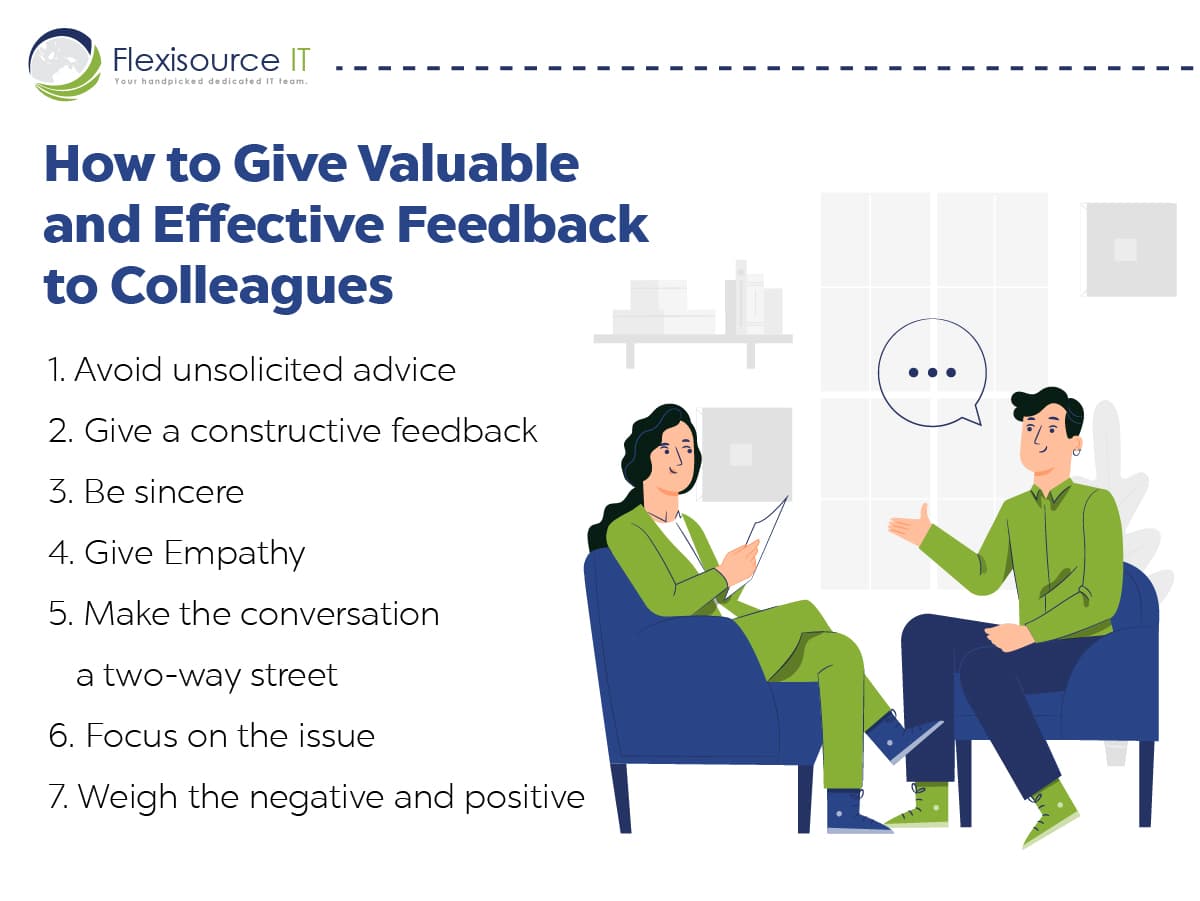Valuable feedbacks are what helps us progress. It helps us learn what we need to improve with skills and capabilities. But let’s face it. Giving the perfect feedback in the workplace is challenging. Even the best and experienced professionals sometimes struggle to provide effective feedback to their subordinates and colleagues.
Still, feedback is a critical element of assessment in the workplace. Giving good constructive feedback will help your team get better at professional and personal skills. And with the right approach, you can help your team achieve the company goals.
The good news is, we have compiled tips on giving feedback to make it easier for you. This article will discuss why feedback is essential, provide examples of feedback for colleagues, and help avoid any performance reviews bias.
Why feedback is essential in the workplace?
Feedback in the Workplace is crucial in any organization. It can clarify company expectations, help people improve their work ethics, and learn from mistakes. For employees, it can help strengthen employees’ progress and development. In short, effective feedback boosts employee confidence to work without errors. Likewise, it provides the following benefits:
1. Opportunity to motivate an employee
Proving positive feedback is a sure way to motivate an employee. It makes the employee feel valued and connected. They think that all their efforts for the organization are recognized and appreciated. Positive feedback is what employee strives for.
As such, employers need to provide feedback on any achievement an employee made. It gives meaning to a job. If employees don’t receive the recognition, they will likely disengage from their tasks as they will think they do it for nothing.
2. Develops employee performance
Effective feedback helps employees grow as professionals. Consistent feedback is essential to steer them in the right direction. It acts as guidance to help them improve and develop their works and ethics.
In addition, it gives employees the opportunity to look at themselves in a different light and identify skills that need to be improved. It helps them see how others see them and how their actions can impact other team members.
3. Enhance peer-to-peer relationship
Feedback is not just for superiors and subordinates. Effective feedbacks should also be encouraged peer-to-peer. It helps strengthen relations and inclusive culture in your company. This culture can help boost collaboration across teams and departments.
Likewise, peer-to-peer feedback can create a harmonious relationship between the team as feedback can be a great avenue to align their tasks and goals.
7 Ways to Give Valuable Feedback to Colleagues
Positive feedback is easy to give to colleagues. Communication is excellent when everything is going well, and it’s not that hard to find the right words to give someone a good job or congratulation.
However, feedbacks cannot always be positive. You need to find the right balance in nurturing your employee’s confidence while helping them improve their capabilities. Giving negative feedback, still, is difficult. Many employees try to avoid having difficult situations, especially if it involves their job and performances. It’s human nature to try to defend themselves and counter anything that makes them look back.
Likewise, constructive feedback may cause issues between managers and colleagues. So, to avoid these issues, here are some tips on how to give effective feedback to staff and employees:

A few people only believe in the importance of feedback and the benefits it gives. It is probably due to people often giving unsolicited advice, which can sometimes create confusion or stress the person receiving it.
Effective feedback is essential to improve one’s skills and efficiency. However, if your subordinate does not ask for feedback directly, ask them when and how they want to receive feedback.
Through this, you can give them control over their tasks and provide them with the initiative to improve their work on their own terms. In addition, this method creates an avenue for open communication and feedback. Your subordinate will more likely approach you for feedback and act on it.
Another great tip for giving feedback is empowering your people to control what areas you will provide feedback on, making them comfortable to ask for it.
2. Give constructive feedback
One common barrier to communication and feedback is when the communicator intrudes in the receiver’s private life or personality when providing advice. This usually creates a blockade between the two and sometimes results in an argument rather than a bit of healthy and practical advice.
Thus, providing effective feedback, make sure to focus on the employee’s work ethics and main issue rather than their personality traits. Below are two constructive feedback examples, and think about what type of feedback would you instead receive:
- Example 1: “Your ego is what makes your work harder.”
- Example 2: “Being meticulous can sometimes lengthen the hours you put on a single task and interfere with the process.”
The first example focuses on the person’s behaviors, while number 2 helps identify which trait needs improvement.
3. Be sincere
Suppose your tone and manner imply hypocrisy rather than genuineness. In that case, the feedback you give your employee could send out mixed messages rather than a piece of practical advice. The employee might think that the company is aloof and disinterested in their work or their contributions.
When giving feedback, it is essential to match the emotions of what you want to insinuate. If your feedback is positive, make sure that you are showing appreciative and congratulatory emotions. For negative feedback, offer a more severe and concerned tone when providing some advice.
Likewise, it is essential to remember not to display negative emotions such as disappointment, sarcasm, anger, and annoyance when giving effective feedback.
4. Give Empathy
To give effective feedback to subordinates and colleagues, we need to empathize with the person is feeling, especially when they are becoming more defensive. As a manager, it’s your job to make your subordinates feel safe and understand their experience.
The more we empathize with a person’s experiences, the more we understand them and attune our feedback to something more appropriate. It allows better communication, mutual understanding, and healthier relationship.
Thus, when providing feedback to team members, make sure to set aside your personal emotions and opinions and understand them first. Also, be prepared to give them space if they need to, especially when they feel shocked upon receiving negative feedback. Remember to not take this as defiance. Instead, think of this as a defense mechanism.
5. Make the conversation a two-way street
When giving effective feedback in the workplace, make sure that the conversation is a two-way street. Give the employee a chance to respond and explain their side of the issue. This allows employees to express their opinions and ideas and become part of the solution rather than the creator of the problem.
People tend to guard themselves when they feel that they are being attacked. And lecturing someone on how they should improve themselves is not adequate.
Thus, be sure that you are ready to listen to their concern and point of view on the topic. Let the receiver reply to your criticism and allow them to ask questions or clarification. Once the issue is clear, you can work together to develop a course of action for the problem.
However, remember to not provide feedback to someone who is not willing to open up the conversation. Let them come to you on their own terms.
6. Focus on the issue
It is essential to start your feedback with the main issue or what they need to improve on. Be clear on the actual problem at hand and structure your feedback around it.
Not starting with the issue might confuse the employee on what the feedback is for and why it is necessary. Giving a background or context on the start will help them identify the topic. Be specific in your feedback and provide actionable solutions for it.
In addition, this method will also help you not get sidetracked on other matters when providing feedback.
7. Weigh the negative and positive
If you want to provide effective feedback, it’s essential to give a balanced perspective – both negative and positive. Providing negative feedback can help employees picture the reality of the issue is. On the other hand, positive criticism will help employees create possible methods to solve the problem and let them know that they have an avenue to grow.
Conclusion
In all aspects, providing feedback is necessary. It’s everywhere – from meetings, assessments, reviews, and even day-to-day interaction with other people.
Likewise, Managers need to practice how to provide feedback to team members. They need to know how to build rapport and encourage an open communication environment for their teams to give and receive feedback.
All feedbacks should be spontaneous, regular, and constructive for it to be effective feedback. And when appropriately delivered, reinforced with positive and negative aspects, your company can build a strong culture, employer-employee relationship, and high retention rate.
Looking to hire your team of IT experts but afraid to immediately lose your asset? Flexisource IT is an expert in employee engagement and retention. Contact us now!









